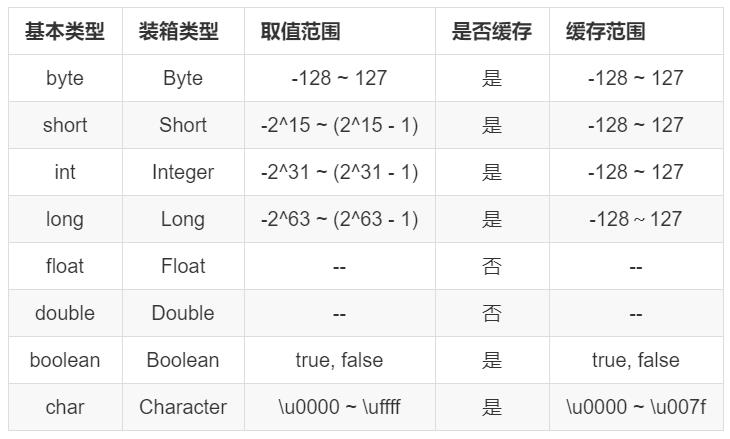面试官:为什么Integer用==比较时127相等而128不相等?
Posted androidstarjack
tags:
篇首语:本文由小常识网(cha138.com)小编为大家整理,主要介绍了面试官:为什么Integer用==比较时127相等而128不相等?相关的知识,希望对你有一定的参考价值。
点击上方蓝色“终端研发部”,选择“设为星标”
学最好的别人,做最好的我们
前言
这个几乎是Java 5引入自动装箱和自动拆箱后,很多人都会遇到(而且不止一次),而又完全摸不着头脑的坑。虽然已有很多文章分析了原因,但鉴于我这次还差点坑了同学,还是纪录下来长点记性。
问题描述
例一
来个简单点的例子
public static void main(String[] args) {
for (int i = 0; i < 150; i++) {
Integer a = i;
Integer b = i;
System.out.println(i + " " + (a == b));
}
}
i取值从0到150,每次循环a与b的数值均相等,输出a == b。运行结果:
0 true
1 true
2 true
3 true
...
126 true
127 true
128 false
129 false
130 false
...
从128开始a和b就不再相等了。
这个例子还容易看出来涉及到int的自动装箱和自动拆箱,下面来个不太容易看出来的。
例二
public static void main(String[] args) {
Map<Integer, Integer> mapA = new HashMap<>();
Map<Integer, Integer> mapB = new HashMap<>();
for (int i = 0; i < 150; i++) {
mapA.put(i, i);
mapB.put(i, i);
}
for (int i = 0; i < 150; i++) {
System.out.println(i + " " + (mapA.get(i) == mapB.get(i)));
}
}
i取值从0到150,mapA和mapB均存储(i, i)数值对,输出mapA的值与mapB的值的比较结果。运行结果:
0 true
1 true
2 true
3 true
...
126 true
127 true
128 false
129 false
130 false
...
为什么两个例子都是从0到127均显示两个变量相等,而从128开始不相等?
原因分析
自动装箱
首先回顾一下自动装箱。对于下面这行代码
Integer a = 1;
变量a为Integer类型,而1为int类型,且Integer和int之间并无继承关系,按照Java的一般处理方法,这行代码应该报错。
但因为自动装箱机制的存在,在为Integer类型的变量赋int类型值时,Java会自动将int类型转换为Integer类型,即
Integer a = Integer.valueOf(1);
valueOf()方法返回一个Integer类型值,并将其赋值给变量a。这就是int的自动装箱。
是同一个对象吗?
再看最开始的例子:
public static void main(String[] args) {
for (int i = 0; i < 150; i++) {
Integer a = i;
Integer b = i;
System.out.println(i + " " + (a == b));
}
}
每次循环时,Integer a = i和Integer b = i都会触发自动装箱,而自动装箱会将int转换Integer类型值并返回;我们知道Java中两个new出来的对象因为时不同的实例,无论如何==都会返回fasle。比如
new Integer(1) == new Integer(1);
就会返回false。推荐:250期面试题汇总
那么例子中Integer a = i和Integer b = i自动装箱产生的变量a和b就不应该时同一个对象了,那么==的结果应该时false。
128以上为false容易理解,但为何0到127时返回true了呢?==返回true的唯一情况是比较的两个对象为同一个对象,那不妨把例子中a和b的内存地址都打印出来看看:
for(int i=0;i<150;i++){
Integer a=i;
Integer b=i;
System.out.println(a+" "+b+" "+System.identityHashCode(a)+" "+System.identityHashCode(b));
}
identityHashCode()方法可以理解为输出对应变量的内存地址,输出为:
0 0 762119098 762119098
1 1 1278349992 1278349992
2 2 1801910956 1801910956
3 3 1468253089 1468253089
...
126 126 1605164995 1605164995
127 127 1318497351 1318497351
128 128 101224864 479240824
129 129 1373088356 636728630
130 130 587071409 1369296745
...
竟然从0到127不同时候自动装箱得到的是同一个对象!从128开始才是正常情况。
看看源码
“从0到127不同时候自动装箱得到的是同一个对象”就只能有一种解释:自动装箱并不一定new出新的对象。
既然自动装箱涉及到的方法是Integer.valueOf(),不妨看看其源代码:
/**
* Returns an {@code Integer} instance representing the specified
* {@code int} value. If a new {@code Integer} instance is not
* required, this method should generally be used in preference to
* the constructor {@link #Integer(int)}, as this method is likely
* to yield significantly better space and time performance by
* caching frequently requested values.
*
* This method will always cache values in the range -128 to 127,
* inclusive, and may cache other values outside of this range.
*
* @param i an {@code int} value.
* @return an {@code Integer} instance representing {@code i}.
* @since 1.5
*/
public static Integer valueOf(int i) {
if (i >= IntegerCache.low && i <= IntegerCache.high)
return IntegerCache.cache[i + (-IntegerCache.low)];
return new Integer(i);
}
其注释里就直接说明了-128到127之间的值都是直接从缓存中取出的。看看是怎么实现的:如果int型参数i在IntegerCache.low和IntegerCache.high范围内,则直接由IntegerCache返回;否则new一个新的对象返回。似乎IntegerCache.low就是-128,IntegerCache.high就是127了。推荐:250期面试题汇总
看看IntegerCache的源码:
private static class IntegerCache {
static final int low = -128;
static final int high;
static final Integer cache[];
static {
// high value may be configured by property
int h = 127;
String integerCacheHighPropValue =
sun.misc.VM.getSavedProperty("java.lang.Integer.IntegerCache.high");
if (integerCacheHighPropValue != null) {
try {
int i = parseInt(integerCacheHighPropValue);
i = Math.max(i, 127);
// Maximum array size is Integer.MAX_VALUE
h = Math.min(i, Integer.MAX_VALUE - (-low) -1);
} catch( NumberFormatException nfe) {
// If the property cannot be parsed into an int, ignore it.
}
}
high = h;
cache = new Integer[(high - low) + 1];
int j = low;
for(int k = 0; k < cache.length; k++)
cache[k] = new Integer(j++);
// range [-128, 127] must be interned (JLS7 5.1.7)
assert IntegerCache.high >= 127;
}
private IntegerCache() {}
}
果然在其static块中就一次性生成了-128到127直接的Integer类型变量存储在cache[]中,对于-128到127之间的int类型,返回的都是同一个Integer类型对象。
这下真相大白了,整个工作过程就是:Integer.class在装载(Java虚拟机启动)时,其内部类型IntegerCache的static块即开始执行,实例化并暂存数值在-128到127之间的Integer类型对象。当自动装箱int型值在-128到127之间时,即直接返回IntegerCache中暂存的Integer类型对象。
为什么Java这么设计?我想是出于效率考虑,因为自动装箱经常遇到,尤其是小数值的自动装箱;而如果每次自动装箱都触发new,在堆中分配内存,就显得太慢了;所以不如预先将那些常用的值提前生成好,自动装箱时直接拿出来返回。哪些值是常用的?就是-128到127了。
解决方法
既然我们的目的是比较数值是否相等,而非判断是否为同一对象;而自动装箱又不能保证同一数值的Integer一定是同一对象或一定不是同一对象,那么就不要用==,直接用equals()好了。实际上,Integer重写了equals()方法,直接比较对象的数值是否相等。
for (int i = 0; i < 150; i++) {
Integer a = i;
Integer b = i;
System.out.println(i + " " + (a.equals(b)));
}
这样返回值就全都是true了。
备注
不仅int,Java中的另外7中基本类型都可以自动装箱和自动拆箱,其中也有用到缓存。见下表:

参考
https://docs.oracle.com/javase/8/docs/api/index.html
来源:www.polarxiong.com/category/java
BAT等大厂Java面试经验总结 想获取 Java大厂面试题学习资料扫下方二维码回复「BAT」就好了回复 【加群】获取github掘金交流群回复 【电子书】获取2020电子书教程回复 【C】获取全套C语言学习知识手册回复 【Java】获取java相关的视频教程和资料回复 【爬虫】获取SpringCloud相关多的学习资料回复 【Python】即可获得Python基础到进阶的学习教程回复 【idea破解】即可获得intellij idea相关的破解教程回复 【BAT】即可获得intellij idea相关的破解教程关注我gitHub掘金,每天发掘一篇好项目,学习技术不迷路!
阅读更多
在华为鸿蒙 OS 上尝鲜,我的第一个“hello world”,起飞!
相信自己,没有做不到的,只有想不到的
在这里获得的不仅仅是技术!


喜欢就给个“在看”
以上是关于面试官:为什么Integer用==比较时127相等而128不相等?的主要内容,如果未能解决你的问题,请参考以下文章